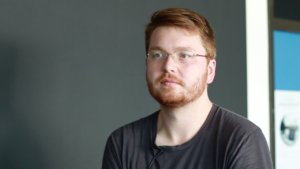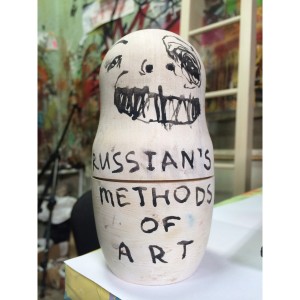Z: Our material is first and foremost our ideas. Just like our name tells you, we live of thinking of new ideas of any kind and these ideas are mostly of physical appearance, mostly sculptures. That’s the material we work with.
Z: Unser Material sind in erster Linie natürlich unsere Ideen. Wie unser Name schon sagt leben wir davon uns neue Ideen in irgendeiner Art und Weise einfallen zu lassen und diese Ideen sind meistens physischer Gestalt. Meistens sind es Skulpturen. Das ist unser Material mit dem wir arbeiten.
H: And our tools, you were asking, are pencil and computer with its software. Programs like Photoshop or 3D programs.
H: Und unser Werkzeug, fragst du ja auch, ist der Bleistift, der Computer mit seiner Software. Programme wie Photoshop und 3D-Programme.
Z: And of course cameras. And the internet.
Z: Kameras gibt es. Internet natürlich.
H: Cameras, the internet, email. Those are all very important tools. In addition to the normal tools of a sculptor, like a hammer.
H: Kameras, Internet, die Email. Das ist ein ganz wichtiges Werkzeug. Plus die normalen Werkzeuge in einer Werkstatt, die ein Bildhauer hat.
Z: Exactly, and what the others have done before. But of course art mainly develops in the mind. I hope or think that this is the case for most artists. For us it is a mixture of a conceptual procedure. As a group we of course have to think conceptual way, otherwise we couldn’t communicate. We have to communicate with each other. This is done via words, that means it is pretty much already conceptual concerning the content when it comes to a first visualization: computer, modeling clay, whatever. Up to an agreement that implements both. You have already drawn something, so something is already physically there and one of your 7.5 ideas that you both mix together to whatever is supposed to be the final product. There are several studios that we go after. It depends on where the artwork is. If we build something in Canada, we have to hire Canadian companies. In Japan we have to hire Japanese ones and here in Berlin or Germany we of course have our own people, with whom we have been working together for a long time and who, in some sort, have an understanding of what is supposed to emerge in the end. They know what kind of material and aesthetic form it should have eventually. From what we have in mind it is always easier to work with them. And of course it’s always about how much it costs. And according to this we also choose the people, whatever.
Z: Genau und was die anderen schon gemacht haben. Ja aber natürlich entsteht die Kunst in erster Linie im Kopf. Ich hoffe oder denke, dass das bei vielen Künstlern so ist. Das ist bei uns eine Mischung aus einem konzeptuellen Vorgehen. Wir müssen als Gruppe natürlich konzeptionell denken sonst können wir uns ja gar nicht unterhalten. Wir müssen ja kommunizieren miteinander. Das geht über Worte, das heißt das ist dann quasi schon inhaltlich konzeptionell in irgendeiner Art und Weise angebunden, über erste Visualisierungen wie auch immer: Computer, Knete, sonst was. Bis hin zu einer Einigung, die quasi beides implementiert. Du hast dann schon mal irgendwas gezeichnet, also irgendwas was physisch vielleicht schon da ist und deine 7,5 Ideen und die mischt zu dann zusammen zu dem was es dann letztendlich als Produkt werden soll. Es sind ja ganz viele Werkstätten, die wir bemühen. Es kommt darauf an wo das Kunstwerk ist. Wenn wir in Kanada was bauen, müssen wir kanadische Firmen beauftragen. In Japan müssen wir japanische nehmen und hier in Berlin oder hier in Deutschland habe wir natürlich unsere Leute, mit denen wir schon lange zusammen arbeiten, die also in irgendeiner Art und Weise auch mitunter, holprige Definition, von dem was dann hinterher entstehen soll, verstehen. Die haben schon quasi ein Verständnis über das Material und über die ästhetische Form, die es letztendlich haben soll. Von dem was wir uns vorstellen ist es halt einfacher mit denen zu arbeiten. Und letztendlich geht es natürlich auch immer darum was es kostet. Und dementsprechend werden natürlich auch Leute ausgesucht, wie auch immer.
H: The companies are also part of our tools. Whether you have a small metal spatula or a metal company that do the same in a bigger size. That is a kind of tool. They aren’t part of the idea process but we need them to physically realize the project.
H: Die Firmen sind auch ein Teil unserer Werkzeuge. Ob man jetzt einen kleinen Metallspachtel hat oder eben eine Metallfirma, die das dann in groß machen kann. Das ist eine Art Werkzeug. Im Ideenprozess sind die nicht mit drin, sondern die brauchen wir, um das dann physisch wirklich herzustellen.
Z: That’s a way to put it.
Z: Um das hinzukriegen ja.

















